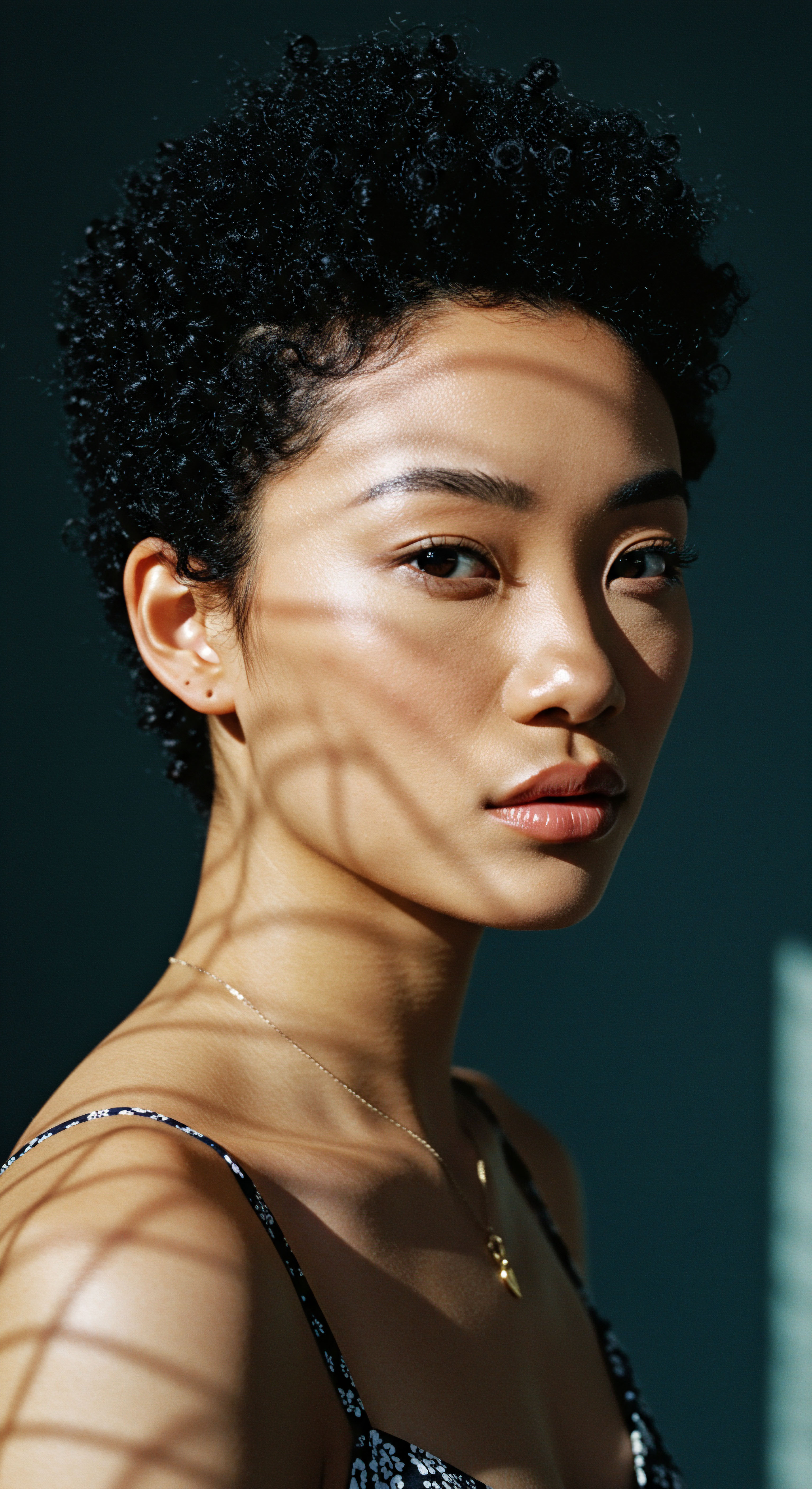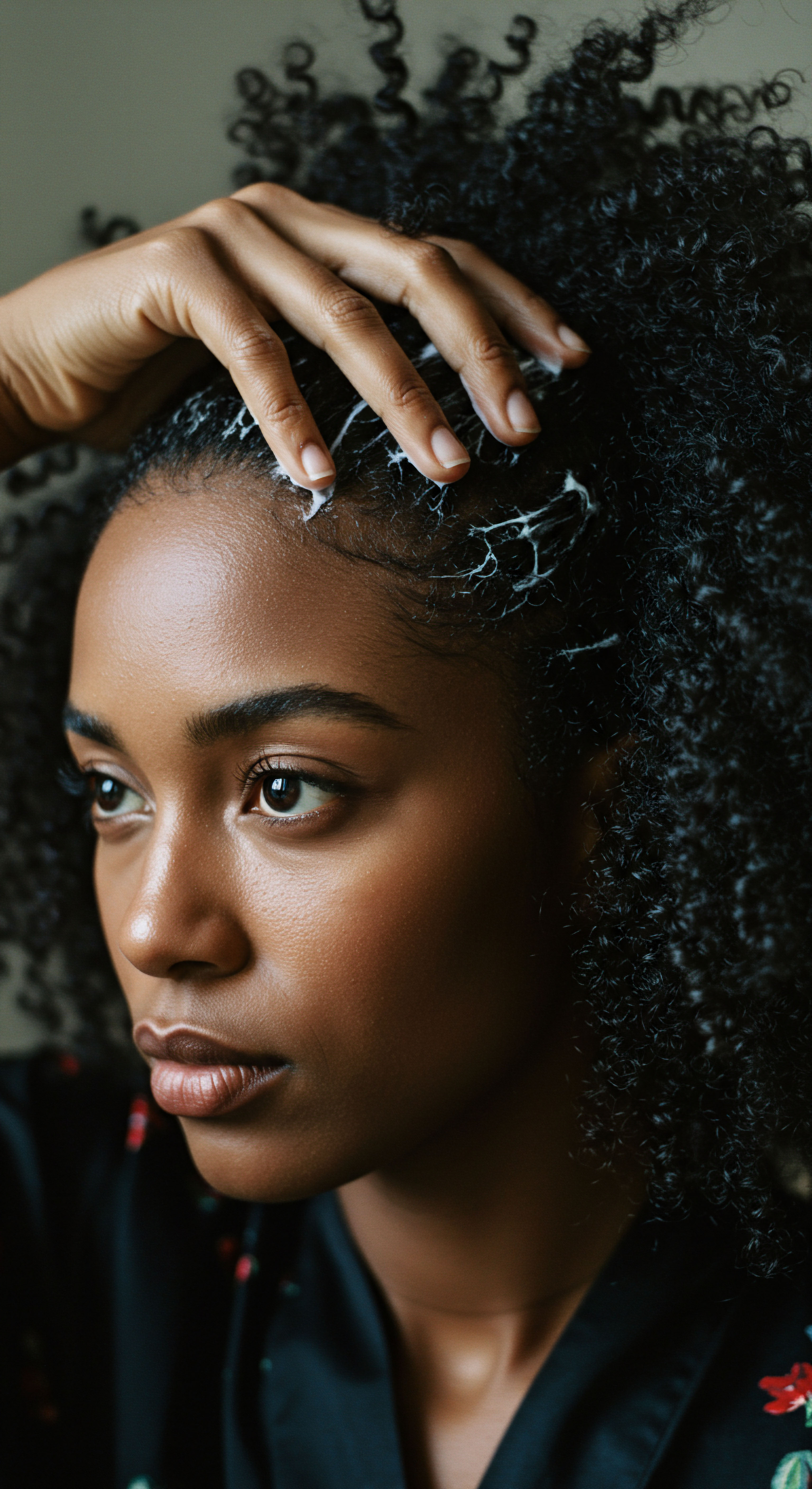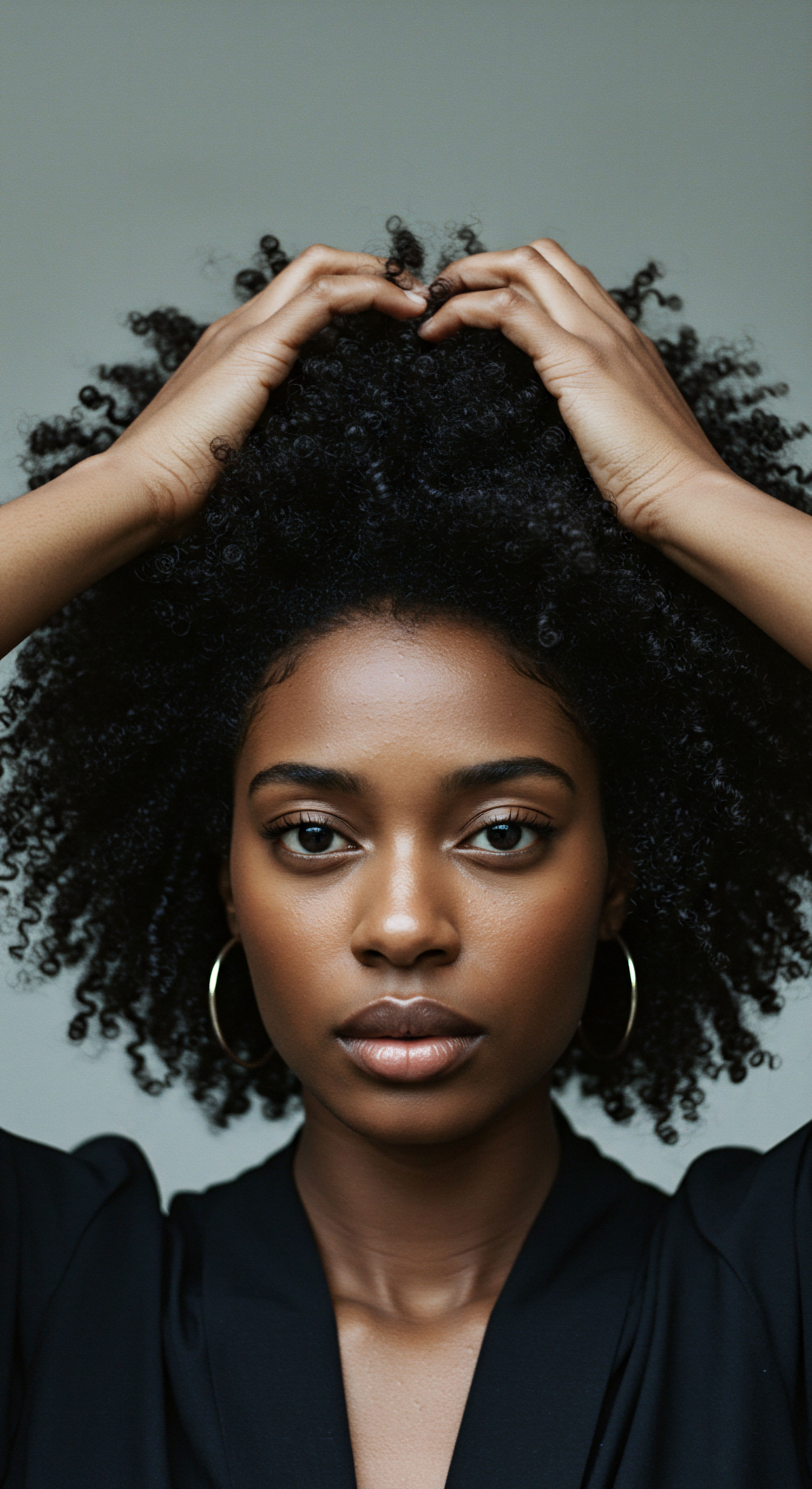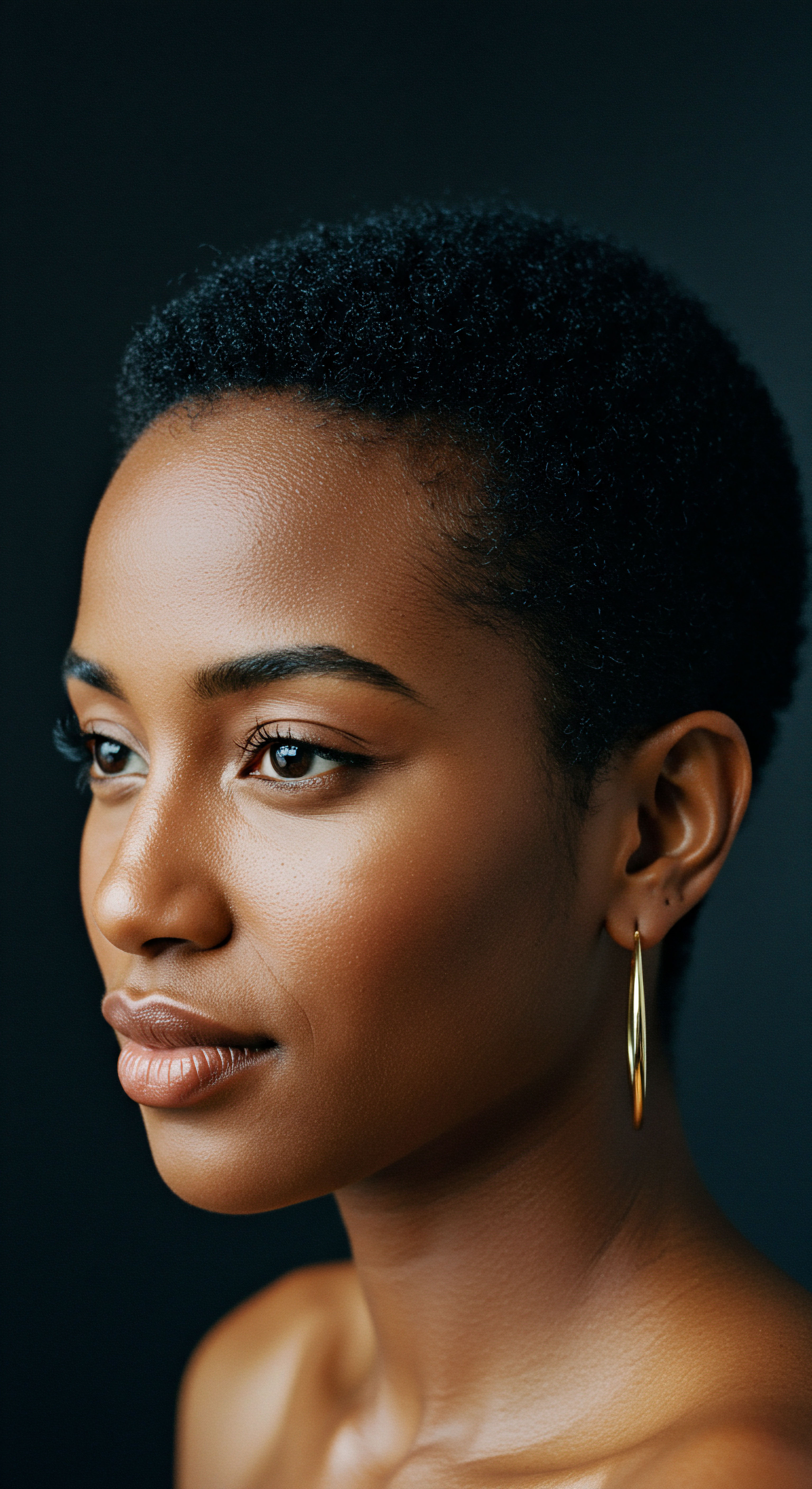
Roots
The quiet descent into night holds more than mere respite for the body; it ushers in a profound restoration, a silent symphony orchestrating the very essence of our vitality. For textured strands, this nightly renewal is not simply a pleasantry but a fundamental requirement, deeply influencing their strength, growth, and overall well-being. We often consider external elixirs and intricate routines, yet the subtle, rhythmic cadence of sleep exerts an influence perhaps more fundamental than any product in a jar. Our hair, like all living things, dances to an internal clock, and when that rhythm finds its calm, textured hair responds with a quiet flourishing.

Hair’s Deep Rhythms and Follicle Activity
Each individual hair follicle, a miniature organ unto itself, possesses an inherent biological clock. This internal timing mechanism, known as the circadian system, guides cellular processes throughout the day and night. During periods of deep, restorative slumber, these cellular rhythms align, creating an optimal environment for follicular activity.
The hair follicle’s ability to regenerate and produce new strands is closely tied to the healthy functioning of its stem cells, and these cells, in turn, are highly sensitive to the body’s natural daily cycles. When the body’s internal clock is consistent, these follicular stem cells operate with greater efficiency, laying the groundwork for robust hair.

Cellular Rejuvenation Beneath the Surface
The deeper stages of sleep, particularly non-REM sleep, are critical for the body’s widespread repair and regeneration. This period sees a significant increase in cellular turnover, where older, damaged cells are replaced with newer, healthier ones. For hair, this translates to the repair of follicles exposed to daily environmental stressors, styling tensions, and even natural metabolic wear.
During this time, the body releases growth hormones, essential for tissue growth and cellular multiplication, including the specialized cells within the hair follicle responsible for hair shaft production. Without adequate deep sleep, these critical repair jobs remain incomplete, potentially leading to strands that feel brittle or appear less vibrant.
The quiet restoration of sleep is a fundamental requirement for the deep cellular renewal that underpins textured hair’s strength and growth.

Nourishment from Within The Scalp’s Circulatory Dance
The scalp, a highly vascularized environment, relies on consistent blood flow to deliver vital oxygen and nutrients directly to the hair follicles. During periods of rest, particularly deep sleep, blood pressure and heart rate stabilize, allowing for enhanced microcirculation to the scalp. This improved blood flow acts as a steady stream of sustenance, ensuring that the hair roots receive the necessary building blocks for healthy development and sustained vitality. When sleep is disturbed, this circulatory rhythm can falter, potentially depriving follicles of the consistent nourishment they require, leading to weaker hair and slowed growth.
The consistent delivery of these elements is especially pertinent for textured hair, which often requires ample hydration and nutrient supply to maintain its unique structural integrity. The delicate coiled or kinky patterns mean that natural oils produced by the scalp can have a more challenging journey descending the hair shaft, making internal nourishment via blood flow even more significant for overall strand health.

Hair Cycle’s Night Shift
Hair growth follows a cyclical pattern with distinct phases ❉ Anagen (the active growth phase), Catagen (a brief transitional phase), and Telogen (a resting phase before shedding). The duration of these phases, particularly the anagen phase, dictates hair length and density. Sleep quality profoundly influences this delicate balance.
Poor or insufficient sleep can prompt hair follicles to prematurely transition from the active growth phase into the resting phase, leading to increased shedding and a reduction in overall hair density. This disruption is often mediated by hormonal imbalances and increased stress responses within the body.
- Anagen ❉ The growth phase, where hair cells rapidly divide, producing new hair.
- Catagen ❉ A short transition where growth ceases and the follicle shrinks.
- Telogen ❉ The resting phase, after which the hair sheds to allow new growth.
| Biological Process Cellular Repair |
| Sleep's Role Deep sleep promotes regeneration |
| Hair Vitality Outcome Stronger, resilient hair strands |
| Biological Process Hormone Production |
| Sleep's Role Balances growth hormones and melatonin |
| Hair Vitality Outcome Supports hair growth and follicle health |
| Biological Process Blood Circulation |
| Sleep's Role Enhances nutrient delivery to scalp |
| Hair Vitality Outcome Nourished roots, reduced shedding |
| Biological Process Circadian Regulation |
| Sleep's Role Maintains follicular rhythm |
| Hair Vitality Outcome Consistent growth cycles, improved density |

Ritual
Stepping beyond the foundational biological rhythms, we consider the intentional acts, the gentle practices that safeguard textured hair as the world slips into slumber. The wisdom passed down through generations, alongside modern understanding, reveals that nighttime care is not merely a habit but a ritual, a purposeful preparation that honors the unique structure of coiled, kinky, and wavy strands. It is in these moments of quiet attention, as day transitions to night, that we offer our hair a sanctuary, setting the stage for its renewal and continued vibrancy. This approach is not about rigid rules but about understanding how mindful actions can protect and nourish hair during its most restorative hours.

Protecting Strands During Rest
The inherent architecture of textured hair, with its varying diameters and natural bends, makes it particularly susceptible to friction and mechanical stress. As one shifts during sleep, strands can rub against abrasive surfaces, leading to tangles, frizz, and breakage. This vulnerability underscores the profound importance of protective measures. Simple yet effective methods, such as gathering hair into loose configurations or enveloping it in smooth fabrics, significantly reduce this nightly wear and tear.

What Styles Preserve Nightly Vitality?
Selecting the right nighttime style is a personal dance, yet several methods consistently offer significant protection:
- Pineappling ❉ Gathering hair loosely atop the head, often with a soft scrunchie, minimizes friction against the pillow and preserves curl definition.
- Loose Braids or Twists ❉ Creating one or several loose braids or two-strand twists keeps hair contained, reducing tangling and friction while maintaining moisture.
- Bantu Knots ❉ These small, coiled buns offer exceptional protection, especially for tighter textures, and can also set a defined curl pattern for the next day.
These styles work by consolidating the hair, limiting its movement, and thereby reducing the physical strain on individual strands and their points of origin on the scalp. The aim is to create a secure, yet gentle, environment for the hair as one rests.

The Sanctuary of Silk and Satin
The surface upon which textured hair rests holds considerable sway over its morning appearance and long-term health. Cotton pillowcases, with their absorbent fibers, draw moisture from the hair, leaving it prone to dryness and friction-induced damage. The solution often lies in materials that offer a smooth, low-friction surface, allowing hair to glide rather than snag.
Silk and Satin pillowcases or bonnets serve as a vital barrier, preventing the loss of natural oils and moisture that textured hair so desperately needs. Their smooth surface also reduces mechanical stress, minimizing frizz, breakage, and tangles. This simple change in nightly ritual provides a gentle shield, allowing the hair’s natural hydration to remain intact and its delicate structure to stay undisturbed throughout the sleep cycle. The choice between a pillowcase and a bonnet often depends on personal preference and hair length, with bonnets offering more comprehensive coverage for longer or fuller styles.
Mindful nighttime practices, from protective styling to silk accessories, create a sanctuary for textured hair, safeguarding its structure and moisture.

Nourishing the Hair as Sleep Approaches
The hours before sleep offer a unique window for deep conditioning and targeted treatments. Applying leave-in conditioners, light oils, or scalp serums before bed allows these products extended time to penetrate and work their magic, unhindered by daytime activity or environmental elements. This prolonged contact supports hair’s hydration levels, particularly for textured hair, which tends to be naturally drier due to its structural pattern.
Consider a light application of a moisturizing cream or a botanical oil to the ends of the hair, gently sealing in moisture. For the scalp, a soothing serum can help maintain its balance and support microcirculation, especially when paired with a gentle fingertip massage. This pre-sleep ritual not only benefits the hair directly but can also contribute to a sense of calm, preparing the body for a more restorative sleep. The integration of these products into a consistent nightly routine reinforces the hair’s natural defenses, ensuring it wakes refreshed and resilient.
| Element Protective Styles |
| Purpose Minimize friction and tangling |
| Benefit for Textured Hair Reduces breakage, preserves curl definition |
| Element Silk/Satin Accessories |
| Purpose Low-friction surface, retains moisture |
| Benefit for Textured Hair Prevents dryness, frizz, and mechanical damage |
| Element Leave-in Products |
| Purpose Deep conditioning, targeted treatment |
| Benefit for Textured Hair Sustained hydration, nutrient absorption |

Relay
As we deepen our understanding of sleep’s influence, we encounter a more intricate landscape, where the body’s internal messaging systems and external environmental factors converge. The connection between sleep cycles and textured hair vitality transcends surface-level observations, revealing a complex interplay of hormones, cellular signaling, and even the subtle imprints of our collective human story. To truly grasp this relationship, we must consider not only the visible strand but the unseen processes that govern its very existence, delving into areas where science offers compelling, sometimes surprising, insights.

The Hormonal Orchestration of Nightly Repair
Sleep is a period of intense hormonal activity, a finely tuned orchestra conducting numerous biological processes. Among the most significant players for hair health are melatonin and cortisol. Melatonin, often known for its role in regulating sleep-wake cycles, also functions as a potent antioxidant, offering protection to hair follicles from oxidative stress. Its presence appears to support the hair follicle’s activity, potentially extending the anagen, or growth, phase of the hair cycle.
Conversely, cortisol, often termed the “stress hormone,” sees its levels naturally decrease during restful sleep. Chronic sleep deprivation or irregular sleep patterns can lead to elevated cortisol levels, creating an environment that is less than ideal for hair growth. High cortisol has been associated with conditions such as telogen effluvium, where hair follicles are prematurely pushed into their resting phase, leading to excessive shedding. The delicate balance between these hormones, maintained through consistent, quality sleep, directly influences the hair follicle’s capacity for sustained, healthy growth.

How Do Circadian Disruptions Affect Follicle Health?
The body’s internal clock, the circadian rhythm, dictates not only sleep patterns but also the rhythmic expression of genes within hair follicles. When this rhythm is disrupted, such as by shift work or inconsistent sleep schedules, the delicate timing of hair growth phases can be thrown off balance. Research indicates that certain “clock genes” are expressed in hair cells at the base of the follicle, influencing how hair stem cells are activated or quieted. Disruptions can hinder these stem cells from performing optimally, potentially slowing hair growth or leading to less robust strands.
A study in the Journal of Drugs in Dermatology highlights melatonin’s potential to extend the anagen phase, noting that topical application of 0.0033% or 0.1% melatonin solution once daily for 90 to 180 days showed positive outcomes in improved scalp hair growth, density, and shaft thickness in individuals with androgenetic alopecia. While this specific research focuses on a particular hair loss condition, it points to melatonin’s broader biological impact on hair follicle dynamics, suggesting a compelling connection between a hormone tied to our sleep cycles and the direct support of hair vitality.

The Unseen Work ❉ Cellular Signaling and Repair Mechanisms
Beyond hormonal regulation, sleep facilitates complex cellular signaling pathways that are essential for hair vitality. During deep sleep, the body activates repair mechanisms that address cellular damage accumulated throughout the day. This includes processes like protein synthesis, where the building blocks for new hair are assembled, and the removal of cellular waste products.
The very structure of textured hair, with its unique bends and curves, requires robust protein integrity to maintain its shape and strength. Disrupted sleep can compromise these repair efforts, leading to weakened protein structures within the hair shaft, making strands more prone to breakage and dullness.
Furthermore, the immune system undergoes significant regulation during sleep. A well-rested immune system is better equipped to manage inflammation, which can otherwise contribute to scalp irritation and negatively impact hair follicle health. Chronic sleep deficits can lead to a state of low-grade inflammation, potentially creating an unfavorable environment for hair growth and contributing to conditions like telogen effluvium.
Sleep facilitates intricate cellular signaling and repair mechanisms, vital for the structural integrity and healthy growth of textured hair.

A Glimpse Beyond Human Hair ❉ Melatonin and Follicle Development
While direct human studies on sleep’s impact on textured hair at a cellular level are ongoing, insights from animal models can sometimes offer intriguing perspectives on fundamental biological processes. For instance, research published in MDPI in 2023 explored the role of exogenous melatonin in promoting the growth of secondary hair follicles and improving cashmere fiber quality in adult cashmere goats. The study indicated that melatonin improved secondary follicle numbers and function, and enhanced fiber quality and yield. This animal research, while not directly transferable to human textured hair, underscores melatonin’s profound influence on hair follicle activity and development across species.
It suggests that the naturally occurring melatonin surge during sleep could similarly support the robustness and quality of human hair, particularly by enhancing antioxidant capacity and modulating gene expression related to hair follicle proliferation. This offers a compelling, albeit indirect, lens through which to consider the deep, universal biological connections between sleep and hair health.
| Sleep Stage Non-REM Deep Sleep |
| Key Biological Activity Growth hormone release, cellular repair, protein synthesis |
| Hair Vitality Benefit Supports hair growth, strengthens strands, aids follicle recovery |
| Sleep Stage REM Sleep |
| Key Biological Activity Increased blood flow to scalp, brain activity |
| Hair Vitality Benefit Delivers nutrients, stimulates follicles, supports mental well-being (indirectly reduces stress on hair) |
| Sleep Stage Consistent Circadian Rhythm |
| Key Biological Activity Hormone regulation (melatonin, cortisol), gene expression timing |
| Hair Vitality Benefit Maintains hair cycle balance, reduces stress-related shedding |

The Interplay of Lifestyle and Rest
The modern pace of life often challenges our ability to achieve consistent, quality sleep. Factors such as screen exposure before bed, irregular schedules, and chronic stress directly disrupt the circadian rhythm and hormonal balance crucial for hair health. The blue light emitted from screens can suppress melatonin production, making it harder to fall into the deep, restorative sleep phases where hair renewal is most active.
Recognizing these external pressures allows for a more comprehensive approach to textured hair vitality. It extends the conversation beyond products to encompass the foundational rhythm of our daily lives. Prioritizing a consistent sleep schedule, cultivating a calming bedtime routine, and managing daily stressors are not just general wellness tips; they are direct investments in the resilience and vibrancy of textured hair. When the body is truly at peace, the hair, too, finds its calm, reflecting an inner state of balance and health.

Reflection
The journey into sleep’s profound connection with textured hair vitality reveals a wisdom far deeper than surface-level beauty. It speaks to the body’s inherent capacity for self-renewal, a nightly re-patterning where each coil and wave is given the quiet permission to thrive. We stand at a crossroads of ancient understanding and modern science, recognizing that the care we give our hair during waking hours finds its deepest validation in the restorative power of our rest.
The strands we cherish are not separate from our overall well-being; they are sensitive barometers, reflecting the rhythms of our inner world. May this understanding prompt a gentle recalibration of our daily lives, inviting more peace, more quiet, and more profound sleep, allowing our textured hair to truly sing with life.

References
- Babadjouni, A. Reddy, M. Zhang, R. et al. (2023). Melatonin and the Human Hair Follicle. Journal of Drugs in Dermatology, 22(3), 260-264.
- Fischer, T. W. Burmeister, G. Schmidt, H. W. & Elsner, P. (2004). Melatonin increases anagen hair rate in women with androgenetic alopecia or diffuse alopecia ❉ results of a pilot randomized controlled trial. British Journal of Dermatology, 150(2), 341-345.
- Fischer, T. W. Trüeb, R. M. Hänggi, G. Innocenti, M. & Elsner, P. (2012). Topical melatonin for treatment of androgenetic alopecia. International Journal of Trichology, 4(4), 236-245.
- Guo, H. Chen, X. Li, X. et al. (2023). Melatonin Promotes the Development of Secondary Hair Follicles in Adult Cashmere Goats by Activating the Keap1-Nrf2 Signaling Pathway and Inhibiting the Inflammatory Transcription Factors NFκB and AP-1. MDPI, 12(2), 332.
- Milani, M. & Fischer, T. W. (2011). Melatonin and hair physiology ❉ reasons and clinical efficacy data as a topical treatment of androgenic alopecia. Medigraphic, 142(1), 30-36.
- Park, H. J. Kim, K. H. Kim, K. H. & Kim, J. H. (2015). The impact of lifestyle factors on hair loss. Journal of Clinical and Aesthetic Dermatology, 8(4), 38-42.
- Sleiman, M. A. et al. (2021). Techniques Used for Hair Style Maintenance while Sleeping May Be a Risk Factor for Traction Alopecia. Journal of Clinical and Aesthetic Dermatology, 14(2), 48-51.
- Tsunenari, T. Aiba, S. & Sugita, T. (2017). Hair Follicles as a Critical Model for Monitoring the Circadian Clock. International Journal of Molecular Sciences, 18(1), 217.
- Vanaelst, B. et al. (2014). Hair cortisol and sleep duration in 12-month old infants. Psychoneuroendocrinology, 42, 163-169.
- Youn, Y. J. et al. (2016). Sleep quality and duration are associated with hair loss in adult women. Journal of Clinical Medicine, 5(8), 69.